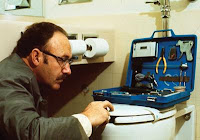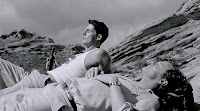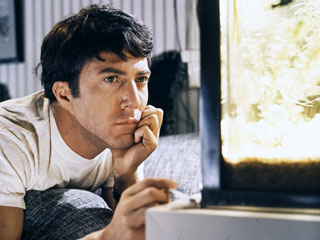First off, we have a major dilemma. When I first created “That One Scene” back in August, I promised to write about one remarkable movie scene every week. Obviously, this didn’t happen.
However, now that I am a second semester senior and certain responsibilities don’t exist for me anymore, I believe now is the perfect time to bring this post back. And now, I’m going to bring it back by discussing a movie I’ve talked about way too much recently: “Inglourious Basterds.” My incessant chatter though is for good reason, as this was a film made to be broken down piece by piece to be fully admired. Also, I hope this serves to show you why this film truly deserves to take home Best Screenplay this year.
There are a multitude of great scenes to break down in this film. I could’ve discussed the stretched out, tension-filled opening scene. I could’ve discussed the audaciously long tavern scene. I also could’ve had some fun and discussed the Bear Jew beating a Nazi with a bat. However, I’ve opted for one of the more subtlety beautiful and less appreciated scenes in the film. It’s a tour-de-force of fine writing, acting, and directing.
The scene occurs after our hero Shosanna (Melanie Laurent), a Jew hiding as a French movie theater owner in Nazi-Occupied Paris, manages to sit through an entire meal with Joseph Goebbels. Hans Landa (Christoph Waltz), the SS Officer responsible for the slaughter of Shosanna’s entire family walks into the room. Quentin Tarantino doesn’t skip a beat going into this scene. The banging drums seem out of place in a WWII epic, but it serves well in sending chills down the viewer’s spine.
As Landa greets her, Shosanna’s skin turns white as a skeleton. Laurent shows her as someone vulnerable enough to crack at any moment. Tarantino spends an awful long time focusing on Shosanna’s facial expressions, basically making the conversations occurring right above her shoulder seem insignificant. Laurent’s acting shows more fear, vulnerability, and ultimate strength in just a few smacks of her lips than any amount of words ever could. For a director so enamored by conversation, this seems like an interesting, and even welcome, change.
This entire scene contains an incredible amount of ambiguity around it. From the beginning, we are nervous of whether or not Landa will recognize Shosanna. By the end, it’s still impossible to tell if he did or not. For someone known as “The Jew Hunter,” Landa maintains a jovial demeanor throughout the scene.
Landa says the purpose of their meeting is to discuss security matters. At times, it seems less for information and more as a means of torture. He even orders Shosanna a glass of milk, the very thing he drank the last time they were acquainted.
Meanwhile, there is a great focus on the strudels. It seems unnecessary, but Tarantino seems to have a great love of shaping human interaction around the things we eat. That lovingly shot close up of Shosanna ripping off a piece of strudel, then piling a little cream onto it, reminds me of watching Samuel L. Jackson devour a Big Kahuna Burger in “Pulp Fiction.” Tarantino seems to think a lot can be said about a person by how they eat their food. In this instance, Shosanna is someone who is careful, and will never miss a detail. Landa, meanwhile, shoves the pastry in his face. This is consistent with much of the humor arising from this character; he seems to be funniest in how outlandish he is in just about everything he does.
It’s strange also to see the weird chemistry between Landa and Shosanna. While one is a Nazi and the other is a secret Jew, they seem quite good in listening to each other and responding to each other’s comments. At times, they chat almost as if they are old friends.
Of course, while parts of this scene may seem very light-hearted, one can forget its extremely serious undertones. After all, this is a film about the topic of genocide. The most serious moment comes as Landa states, “I did have something else I wanted to ask you.” His smile so quickly turns into a frown, showing how his character can go so quickly from kind to cruel. Shosanna of course, tries to stand her ground. Tarantino takes no hesitation in lingering on this long, frightful silence.
Suddenly, Landa’s deathly stare turns into an all-out smile. He states, “But right now, for the life of me, I can’t remember what it is. Oh well, must not have been important.” This reveals something very important about Landa. Throughout the film, he seems to constantly be on the line between very serious man, and cartoonishly over-the-top. He is a villain so frightening in his insane self-centered principles. Yet, here, he is as clueless as the conventional Hollywood villain who’s too underwritten to stop his foe.
In this case, it’s not poor writing, but some form of satire. That, and it reveals Landa as the most complex Nazi we may ever see on film.
If we look at it from the possibility that he did know it was her, why wouldn’t Landa try and stop her? Well, maybe he didn’t want to because he enjoys torturing her with mystery better. Also, Landa is always fixated on the idea of survival. He seems to hold great respect for those who will do anything to survive. This is why many believe he let Shosanna run away at the beginning. Now, he sees that she is not only surviving, but thriving (like the rats he discusses earlier in the film). He may be simply amazed at how she overcame so much to come this far, and that she deserves to remain in secret.
After Landa leaves, we get to see why Laurent deserved an Oscar nomination this year. After Landa leaves, her feigned smile quickly turns into a frown. When she sees she is completely alone, she lets out a giant gasp and begins crying. It seems almost as if she’s been under the identity of Emmanuelle for so long that she forgot how to feel like Shosanna. It’s strange how she turns around to see if it’s okay to cry; as this makes it seem like her reaction is almost mechanical. However, Laurent manages to make it the most emotionally realistic moment in the entire film. It could also be that she, like the audience, can’t believe she’s made it this far. In this way, Laurent turns Shosanna perhaps into the film’s most relatable character.
Overall, this scene seems to be an embodiment of what “Inglourious Basterds” is truly about: a celebration of the finer things in culture. This ranges from good cinema to good Scotch, good cigarettes, and of course, a fine dessert. Here is a scene that represents why Tarantino is the auteur of our generation: he has an incredible understanding of humanity, timing, and detail.
 Of all the movies I’ve seen, even the strangest still give me something to say. It is at the rarest occasion that I am almost at a loss for words. One of these rare occasions occurred as I watched Duncan Jones’ “Moon.”
Of all the movies I’ve seen, even the strangest still give me something to say. It is at the rarest occasion that I am almost at a loss for words. One of these rare occasions occurred as I watched Duncan Jones’ “Moon.”
 The next time somebody says to you, “they don’t make ‘em like they used to,” know that they’re likely talking about “The Conversation.” Nobody observes time and space while fully exploiting all the great elements of film quite like Francis Ford Coppola did.
The next time somebody says to you, “they don’t make ‘em like they used to,” know that they’re likely talking about “The Conversation.” Nobody observes time and space while fully exploiting all the great elements of film quite like Francis Ford Coppola did.
 I spend a lot of time on this blog talking about Quentin Tarantino. And over the past few posts, I’ve mentioned “Inglourious Basterds” at least once. You’re probably so sick of the name by now. However, this is one piece of news you just may have to hear.
I spend a lot of time on this blog talking about Quentin Tarantino. And over the past few posts, I’ve mentioned “Inglourious Basterds” at least once. You’re probably so sick of the name by now. However, this is one piece of news you just may have to hear.
 Ignore the posters that make this film out to be a romance between Colin Firth and Julianne Moore. Ignore the buzz that makes this film seem like nothing more than a “gay movie.” “A Single Man” is much more than a romance of any kind. “A Single Man” is a film with amazing depth, but unfortunately, falls just short of perfection.
Ignore the posters that make this film out to be a romance between Colin Firth and Julianne Moore. Ignore the buzz that makes this film seem like nothing more than a “gay movie.” “A Single Man” is much more than a romance of any kind. “A Single Man” is a film with amazing depth, but unfortunately, falls just short of perfection.
 Melanie Laurent (Inglourious Basterds)- In a film powered by raw, unforgiving violence, Laurent was the true heart of “Basterds.” Her emotional performance as a Jew hiding in Nazi-Occupied France truly brought sympathy for this lady vengeance. By the end, when she’s become nothing but a hovering, etherial cloud of smoke, her human presence is never gone. No, it’ll live on in “Too Good for the Oscars” immortality.
Melanie Laurent (Inglourious Basterds)- In a film powered by raw, unforgiving violence, Laurent was the true heart of “Basterds.” Her emotional performance as a Jew hiding in Nazi-Occupied France truly brought sympathy for this lady vengeance. By the end, when she’s become nothing but a hovering, etherial cloud of smoke, her human presence is never gone. No, it’ll live on in “Too Good for the Oscars” immortality.



 The beginning of “An Education” might throw you off a bit. For a premise that sounds so trite, the music is so upbeat and unexpected. It’s basically an indicator for what’s to come: a surprising, refreshing, and extremely entertaining British drama.
The beginning of “An Education” might throw you off a bit. For a premise that sounds so trite, the music is so upbeat and unexpected. It’s basically an indicator for what’s to come: a surprising, refreshing, and extremely entertaining British drama.
 I meant to write this post on Thursday or Friday. Hopefully, this topic hasn’t lost its relevance yet.
I meant to write this post on Thursday or Friday. Hopefully, this topic hasn’t lost its relevance yet.


 Some things are too ridiculous to be true. Other things, when put into the right context, are too ridiculous to not be true. This is the very case for “In the Loop.” Its a very relevant political satire about ridiculous characters and situations during a very ridiculous period in history.
Some things are too ridiculous to be true. Other things, when put into the right context, are too ridiculous to not be true. This is the very case for “In the Loop.” Its a very relevant political satire about ridiculous characters and situations during a very ridiculous period in history.


